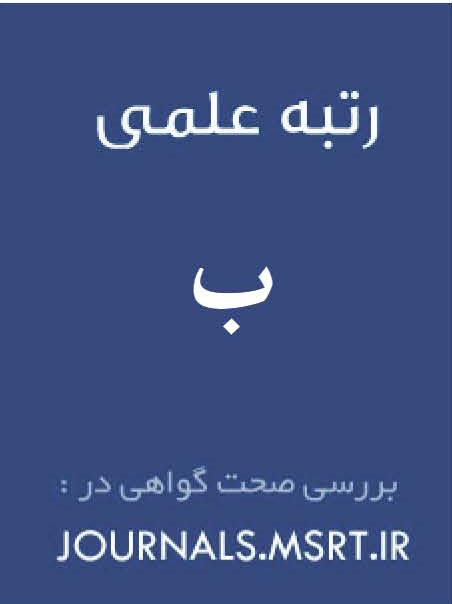Modeling the Competencies of Knowledge-Based Companies Using Structural Equation Modeling (Case Study: Incubators and Science and Technology Parks)
Keywords:
structural equations, modeling, knowledge-based companiesAbstract
The purpose of the present research was to model the competencies of knowledge-based companies using structural equation modeling. This study is applied in nature and, in terms of methodology, is a mixed-methods research (qualitative–quantitative). The statistical population of the research consisted of 7 to 12 experts whose opinions were used in the qualitative section to identify categories. For the modeling stage, the statistical population comprised managers and experts familiar with the field of competencies of knowledge-based companies located in incubators and science and technology parks. Cochran’s formula for unknown populations was used, and the sample size was determined to be 384 individuals. The sampling method was available random sampling. To identify the factors, categories and concepts were first extracted through interviews. The result of this stage yielded 31 axial codes and 358 open codes. Next, in the following stage, the Delphi technique was applied, through which causal, contextual, intervening, strategic, and consequential conditions were screened across three rounds. Ultimately, consensus was reached on 102 open codes and 31 selected codes. Finally, structural equation modeling and partial least squares were employed using Smart PLS software for the modeling stage. The findings of the research indicated that the competency model of knowledge-based companies is formed under 7 causal conditions, 4 contextual conditions, 6 intervening factors, and 6 strategies. Ultimately, 7 major consequences for knowledge-based companies located in incubators and science and technology parks were identified. These consequences, in order of priority, include organizational growth, improvement of organizational strategic thinking, resilience of human resource processes, improvement of organizational conditions, organizational outcomes, enhancement of organizational efficiency, and an increase in the level of organizational competitiveness. Based on the results of this research, it can be concluded that in the process of competency modeling for knowledge-based companies located in incubators and science and technology parks, attention should be given to a wide range of factors, criteria, and sub-criteria in order to achieve appropriate results and maximize productivity.
Downloads
References
Abedini, H., Rahnavard, F., & Gholami Goloozan, A. A. (2021). Designing Professional Competency Models for Knowledge Workers in Knowledge-Based Organizations in the Public Sector. Human Resources Studies Quarterly, 11(4), 1-24.
Afsharnajad, A., Shabani, M., Amini Sabeq, Z. a.-A., & Sadeh, E. (2021). A competency model for financial managers in the National Iranian Oil Company. Quarterly Journal of Human Resource Education and Development, 30(8), 224-239. https://doi.org/10.52547/istd.31464.8.30.224
Afsharnejad, A., Shabani, M., Amini Sabegh, Z. A.-A., & Sadeh, E. (2021). Presenting a Competency Model for Financial Managers in the National Iranian Oil Company. Quarterly Journal of Training and Human Resource Development, 30(8), 224-239. https://doi.org/10.52547/istd.31464.8.30.224
Anabestani, A., Tavakoli, J., & Arzhang, Z. (2022). Analysis of Key Drivers Influencing the Competitiveness Components Shaping a Knowledge-Based Economy. Urban Economy and Planning, 3(3), 212-227.
Armanmani, S., & Shafiei, A. (2017). Competitive capabilities in knowledge-based companies: A model for explaining the role of strategic agility and strategic learning. Improvement and Transformation, 25(83), 25-50. https://jmsd.atu.ac.ir/article_7477_en.html
Farahani Majid, N., Seyed Naghavi, M. A., & Mehrabi, J. (2023). Designing the human resource Retention Model in knowledge-based organizations: A Review of Experts` views. Journal of public Administration Mission, 14(1), 1-18. https://www.magiran.com/paper/2595767
Gravand, A., & Nejati Pilehroud, F. (2023). Increasing sustainable competitive advantage through knowledge-based leadership and human resource development in the banking industry. 7th Conference on Economic and Management Studies in the Islamic World, https://civilica.com/doc /1753630
Istikhoroh, S., & Ardhiani, M. R. (2022). Creating a Competitive Advantage for Universities Through Knowledge-Based Strategic Assets Management. Kne Social Sciences. https://doi.org/10.18502/kss.v7i19.12443
Jackson, S. E., & Hitt, M. A. (2003). The knowledge-based approach to sustainable competitive advantage. Jossey Bass. https://books.google.com/books?hl=en&lr=&id=b-qui0OL_8UC&oi=fnd&pg=PA3&dq=Jackson,+S.+E.+and+M.+A.+Hitt+(2003).+%22The+knowledge-based+approach+to+sustainable+competitive+advantage.%22+Jossey+Bass.+%09&ots=hRVuAy829c&sig=z_MJvoC2by8zwhQ60unob8jJ9b0
Kandarani, A., Younesi, J., Zamanpour, E., Farrokhi, N., Salimi, M., & Moghaddamzadeh, A. (2025). Designing and Validating a Model of Specific Competencies for Managers of Iran's Oil Terminals Company. Educational Leadership Research Quarterly, 9(33), 229-258.
Lubis, F. M., Febrian, W. D., & Wijaya, I. K. K. (2024). Exploration of Competency-Based Performance Management Practices in Driving Employee Career Development: A Case Study in the Financial Services Company. Dinasti International Journal of Economics, Finance & Accounting, 5(2), 736-745. https://dinastipub.org/DIJEFA/article/view/2639
Lyapina, S. Y., Degtyareva, V. V., & Tarasova, V. N. (2021). Intelligent technologies for knowledge management at a modern company. In Digital Economy and the New Labor Market: Jobs, Competences and Innovative HR Technologies (pp. 459-469). https://doi.org/10.1007/978-3-030-60926-9_59
Mahdi, O. R., Nassar, I. A., & Almsafir, M. K. (2019). Knowledge management processes and sustainable competitive advantage: An empirical examination in private universities. Journal of Business Research, 94, 320-334. https://doi.org/10.1016/j.jbusres.2018.02.013
Mlaouhi, K., Cholez, C., & Gzara, L. (2022). An Action-based Model to Identify Human Competencies through the Trace of Actions: Case of a Building Energy Engineering Company. IFAC-PapersOnLine, 55(10), 169-174. https://doi.org/10.1016/j.ifacol.2022.09.385
Paimaneh, F., Zayandehroudi, M., & Jalaei, M. (2024). Identifying and Explaining the Impact of Competitiveness and Knowledge-Based Economy Indicators on the Resilience of Iran's Economy. Applied Economic Theories, 11(1), 207-240.
Pooramini, Z., & Ebrahimpour, H. (2023). A Conceptual Model of Employability Skill for Technology and Knowledge-Based Enterprise. Journal of Entrepreneurship Development, 16(3), 47-65. https://www.magiran.com/paper/2660548
Rahimi Kaloor, H., & Azarbayejani, M. (2021). Provide an open strategy implementation model in knowledge-based companies. Journal of Business Management Perspective, 20(47), 137-163. https://doi.org/10.52547/jbmp.20.47.137
Rahmani, S., Mosakhani, M., & Samari, D. (2021). Identifying and prioritizing the dimensions and components of entrepreneurial competence of investment applicants in Iran's free zones. Journal of Development & Evolution Mnagement(1), 11-21. http://sanad.iau.ir/fa/Article/948657
http://sanad.iau.ir/fa/Article/Download/948657
Ramazani Panah, N., Allameh, S. M., Samavatiyan, H., & Ghaninia, M. (2020). Designing a Competency Model for Senior and Mid-Level Managers at National Petrochemical Company of Iran. Executive Management Research Journal, 12(24), 133-155.
Ramezanpanah, N., Allameh, S. M., Samavatian, H., & ghanenia, m. (2020). Designing model of competencies development for top and middle managers of the National Iranian Petrochemical Company [Research]. Strategic studies in the oil and energy industry, 11(44), 65-94. http://iieshrm.ir/article-1-886-en.html
Salimi Bazneshini, S., Hosseini Golafshani, A., Rahman Nasht, H., & Rabiei, M. (2022). Providing a competency model for talent identification and succession planning in the National Gas Company. Strategic Studies in Oil and Energy, 13(Summer), 53. https://www.google.com/url?sa=t&source=web&rct=j&opi=89978449&url=https://iieshrm.ir/article-1-1394-fa.html&ved=2ahUKEwjBpNCAwI2OAxXbX_EDHZVdBjAQFnoECBoQAQ&usg=AOvVaw0s65rdb-7YvW2HoL4cZDz7
Sasani, A., Shah Hosseini, M. A., & Rezvani, M. (2019). Presenting a Regional Competitiveness Model Based on the Knowledge-Based Entrepreneurship Ecosystem Structure. Human Resource Management in the Oil Industry Quarterly(44), 33-64. https://sid.ir/paper/390093/en
Van Luu, T., & Chromjaková, F. (2024). Knowledge-based circular economics model for sustainable competitiveness: framework development and analysis. Environment, Development and Sustainability, 1-20. https://doi.org/10.1007/s10668-023-04415-2
Yar Ahmadi, L., Arefi, M., & Vahdati, H. (2023). Examining the Impact of Intra-Organizational Characteristics on Competitive Advantage with the Mediating Role of Entrepreneurial Marketing in Knowledge-Based Organizations. Productivity management, 17(64), 71-92.
Downloads
Published
Submitted
Revised
Accepted
Issue
Section
License
Copyright (c) 1404 لیلا رمضانپور (نویسنده); حسین کاظمی; محمد ضیاء الدینی, ملیکه بهشتی فر (نویسنده)

This work is licensed under a Creative Commons Attribution-NonCommercial 4.0 International License.


